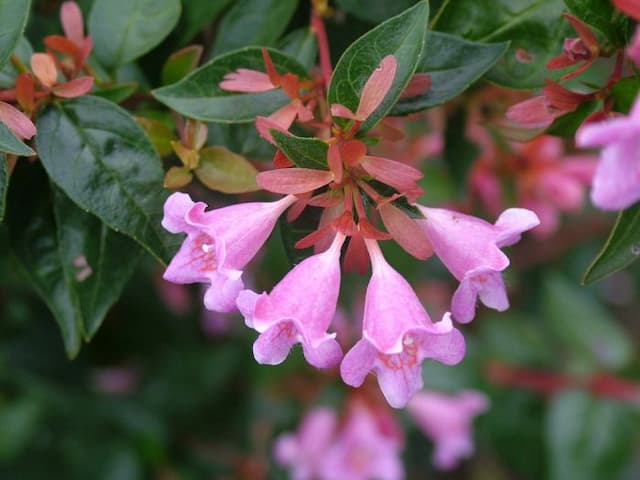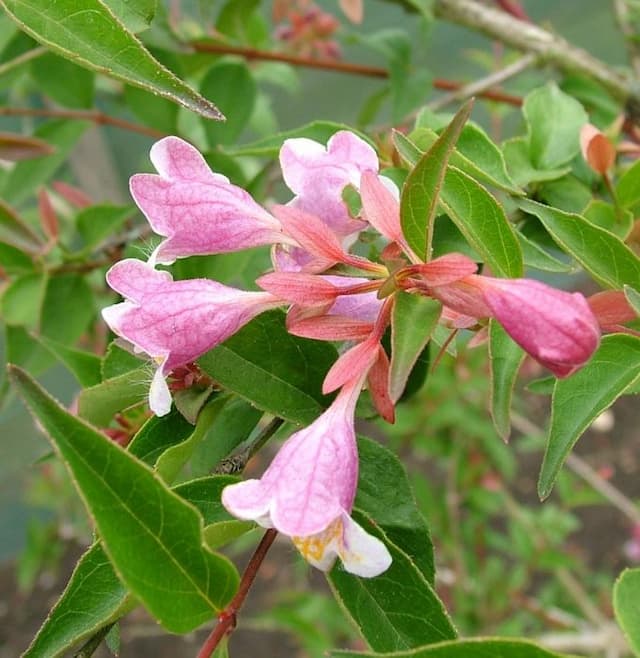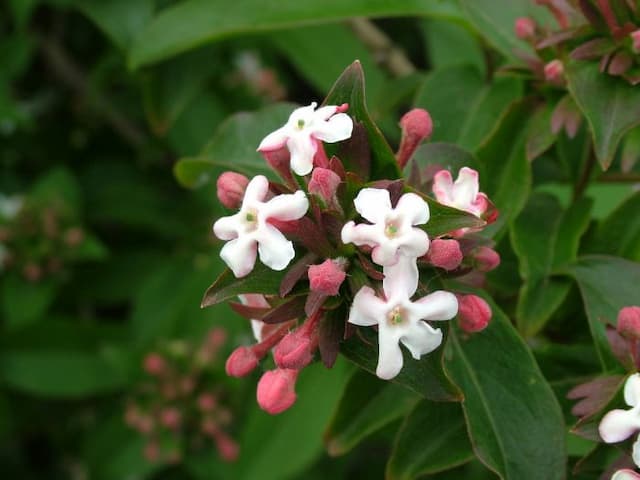Weigela Weigela Pink Poppet = 'Plangen' (PBR)
![weigela [Pink Poppet]](/_next/image?url=https%3A%2F%2Fplants-admin.emdemapps.com%2Fimages%2Fplants%2F%2Fimages%2F604b55df4b1a7.png&w=3840&q=75)
ABOUT
The Weigela Pink Poppet presents a delightful visual display with its profusion of pink flowers that graciously adorn the shrub. These trumpet-shaped blooms radiate a soft, candy-pink hue, clustering along the branches and creating a lovely contrast against the lush green foliage. The leaves of the Weigela Pink Poppet have a clean, ovate shape with a tendency to display a lightly serrated margin, presenting a fresh, deciduous backdrop throughout the blooming season. The overall impression of the Weigela Pink Poppet is of a charming, colorful shrub that offers a cheerful presence in the garden landscape. Its compact nature makes it ideal for a variety of garden settings, where its floriferous display can be appreciated up close.
About this plant
 Names
NamesFamily
Caprifoliaceae.
Synonyms
Weigela Pink Poppet, Dwarf Weigela.
Common names
Weigela Pink Poppet = 'Plangen' (PBR).
 Toxicity
ToxicityTo humans
Weigela is generally not considered toxic to humans. There are no common reports of poisoning from ingesting parts of the Weigela plant. However, as with any plant material, individual sensitivities or allergic reactions could occur, leading to symptoms such as dermatitis or mild gastrointestinal upset but this is not common.
To pets
Weigela is also typically not toxic to pets such as dogs and cats. It is not commonly known to cause any significant symptoms of poisoning if pets ingest parts of the plant. As with humans though, individual animals may have different sensitivities and could potentially experience mild gastrointestinal upset, but serious toxicity is unlikely.
 Characteristics
CharacteristicsLife cycle
Perennials
Foliage type
Deciduous
Color of leaves
Green
Flower color
Pink
Height
1-2 feet (0.3-0.6 meters)
Spread
2-3 feet (0.6-0.9 meters)
Plant type
Shrub
Hardiness zones
4-8
Native area
Asia
Benefits
 General Benefits
General Benefits- Compact Growth: The Weigela Pink Poppet is known for its compact size, making it suitable for small gardens or limited spaces.
- Attractive Flowers: It produces beautiful pink trumpet-shaped flowers which can add a splash of color to any garden.
- Easy to Cultivate: This plant is relatively easy to grow and maintain, requiring minimal care once established.
- Attracts Wildlife: The vibrant blooms are attractive to bees and butterflies, supporting local biodiversity.
- Drought Resistant: Once established, it has a good level of drought tolerance, making it suitable for gardens with less frequent watering.
- Seasonal Interest: With a long flowering season, it provides visual interest from late spring to early summer.
- Hardy: Weigela Pink Poppet is hardy in many climates, capable of withstanding winter temperatures.
- Low Maintenance: It doesn't require regular pruning, and is generally pest-free, which translates to less upkeep for gardeners.
- Deer Resistant: The plant is not a favorite among deer, reducing the likelihood of damage from grazing.
- Landscape Versatility: Can be used in various landscape designs, including borders, foundation plantings, and as a standalone specimen.
 Medical Properties
Medical PropertiesThis plant is not used for medical purposes.
 Air-purifying Qualities
Air-purifying QualitiesThis plant is not specifically known for air purifying qualities.
 Other Uses
Other Uses- Weigela Pink Poppet can be incorporated into a sensory garden for its attractive, touch-friendly foliage and fragrant flowers that can provide a tactile and olfactory experience.
- It's suitable for use in themed gardens, especially Asian-themed gardens, as Weigela is native to East Asia, bringing an authentic touch to the garden's aesthetic.
- Weigela Pink Poppet can be used in educational settings or botanic gardens to demonstrate pruning techniques since it responds well to pruning and can be shaped effectively.
- This plant can be part of a wildlife garden as it attracts hummingbirds and beneficial insects, providing a natural habitat and food source.
- The dense foliage of Weigela Pink Poppet can be used as a natural screen or informal hedge for privacy in suburban gardens.
- Artists and photographers may use the vibrant flowers and overall structure of the plant as a subject for art pieces or photographic work.
- Weigela Pink Poppet can be used as a living mulch; when planted closely, its foliage can suppress weeds and help retain soil moisture.
- As a deciduous shrub, it can also serve as a seasonal barometer in gardens, with its leaves indicating the changing of seasons from spring growth to autumn senescence.
- The plant can provide a natural backdrop for outdoor social areas, complementing garden furniture and providing a serene setting.
- In larger landscapes, it can be used as part of a succession planting strategy, where different plants take center stage throughout the year, with Weigela Pink Poppet blooming in late spring.
Interesting Facts
 Feng Shui
Feng ShuiThe Weigela is not used in Feng Shui practice.
 Zodiac Sign Compitability
Zodiac Sign CompitabilityThe Weigela is not used in astrology practice.
 Plant Symbolism
Plant Symbolism- Admiration: The delicate pink blooms of Weigela symbolize admiration and can convey a gentle fondness for someone.
- Romance: Pink flowers often represent love and romance, making Weigela an appropriate choice for romantic occasions and gestures.
- Grace: Weigelas have a graceful growth habit and flower presentation, echoing the idea of elegance and poise in one's life.
- Resilience: As a hardy shrub, Weigela symbolizes resilience and the ability to thrive in diverse conditions, often reflecting personal perseverance.
- New Beginnings: The spring bloom of Weigela is indicative of new beginnings, rebirth, and the start of something beautiful.
 Water
WaterThe Weigela Pink Poppet should be watered deeply and less frequently to encourage root growth, roughly once a week providing about 1 to 1.5 gallons of water each time during its growing season. During periods of drought or extreme heat, you may need to increase watering to every few days. It's essential not to overwater, as Weigela does not like to sit in wet soil, so ensure the soil dries out somewhat between watering sessions. In the winter months, reduce watering as the plant's water requirements diminish. This plant prefers a consistent watering schedule to thrive.
 Light
LightThe Weigela Pink Poppet thrives in full sun to partial shade conditions. It prefers to receive at least 6 hours of direct sunlight daily, which promotes healthy growth and abundant flowering. The ideal spot for this shrub is in an area that gets morning sun and afternoon shade, especially in regions with very hot summers.
 Temperature
TemperatureThe Weigela Pink Poppet is cold hardy and can withstand temperatures as low as -20 to -30 degrees Fahrenheit. It performs best in a range where summer temperatures do not exceed 90 degrees Fahrenheit. The ideal temperature for this shrub to flourish is between 40 and 75 degrees Fahrenheit.
 Pruning
PruningPruning the Weigela Pink Poppet is done to maintain shape, revitalize growth, and remove any dead or damaged branches. It is best pruned right after it finishes blooming in late spring or early summer, to ensure the flowering for the next year is not affected. Prune sparingly, removing only about one-third of the oldest branches each year, to keep the plant looking full and robust.
 Cleaning
CleaningAs needed
 Soil
SoilWeigela Pink Poppet prefers well-draining garden soil with a mix of peat, compost, and sand to encourage good root health. The ideal soil pH for this plant is between 5.5 and 7.5, ensuring a slightly acidic to neutral environment for optimal growth.
 Repotting
RepottingWeigela Pink Poppet does not typically require frequent repotting as it is a shrub planted outdoors. Repotting might be necessary every 3-5 years if grown in a container to provide fresh soil and additional space for roots.
 Humidity & Misting
Humidity & MistingWeigela Pink Poppet is adaptable but prefers average to high humidity levels. It thrives outdoors in the moisture provided by the natural climate without the need for additional humidity control.
 Suitable locations
Suitable locationsIndoor
Provide bright light, not direct sun, and well-draining soil mix.
Outdoor
Plant in well-drained soil, full sun to partial shade, moderate water.
Hardiness zone
4-8 USDA
 Life cycle
Life cycleThe Weigela 'Pink Poppet' begins its life cycle when a seed germinates in spring, given the right conditions of soil warmth and moisture. As it emerges, it develops into a seedling with a basic root system and foliage, which will expand as it enters the vegetative stage, growing more leaves and stems. During late spring and early summer, the 'Pink Poppet' enters its flowering stage, producing its characteristic pink flowers which attract pollinators and can lead to seed formation if fertilization occurs. After the flowering period, the plant may enter a period of dormancy, especially in regions with cold winters, where growth slows or ceases, and the plant rests. Come the next spring, the cycle can begin anew, with existing plants producing new growth and flowers, while any dispersed seeds may germinate to start new plants. With proper care, including pruning after flowering to encourage new growth and maintain shape, Weigela 'Pink Poppet' can live for many years, continually repeating this cycle.
 Propogation
PropogationPropogation time
Spring-Early Summer
The Weigela 'Pink Poppet', known for its attractive pink blooms and compact growth, is typically propagated by semi-hardwood cuttings. This method of propagation is often done in late summer. To propagate, one would select a healthy, non-flowering stem around 4 to 6 inches (10 to 15 centimeters) in length and cut it just below a node. Leaves on the lower half of the cutting should be removed, and the cut end may be dipped in rooting hormone to encourage root development. The prepared cutting is then placed in a well-draining soil mix, ensuring that at least two nodes are buried where leaves were removed. The environment should be kept moist but not overly wet, and a high humidity level maintained until roots have formed, often indicated by new growth at the top of the cutting. This process can take several weeks, and once the cuttings are well-rooted and showing robust growth, they can be transplanted to a more permanent location.








![Himalayan honeysuckle [Golden Lanterns]](/_next/image?url=https%3A%2F%2Fplants-admin.emdemapps.com%2Fimages%2Fplants%2F%2Fimages%2F604b55302cc87.png&w=640&q=75)
